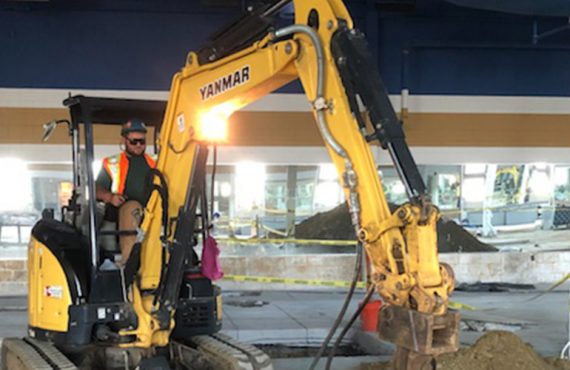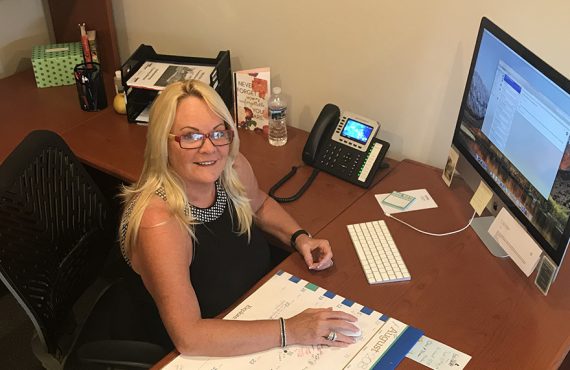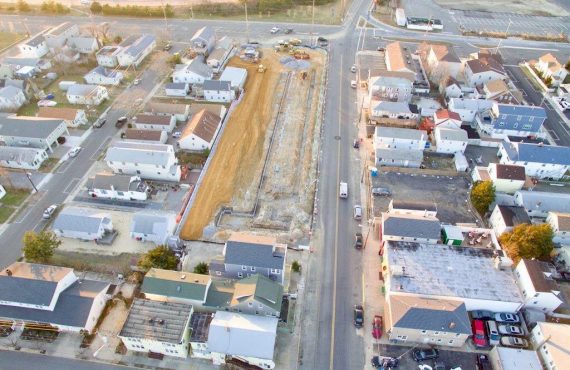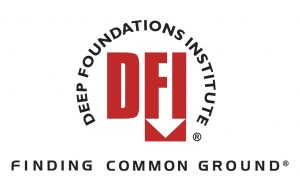By Caitlin Haffert
Ten days shy of my dad’s 13th birthday, all hell broke loose. The ’62 Storm hit his (and later, my) hometown with an unprecedented fury, leaving piles of rubble where houses once stood a mere 12 hours before. I remember the first time my grandmother told me the story of the storm: the chandelier crashing on the dining room table as they sat down to dinner; everyone thrown to the ground as the house shifted; the men attempting to stop the sea from breaking down the front doors; and my grandfather’s fateful words to my grandmother, “Helen, take the children and run.” Then there was the actual running part. And the separations. And the fear. This went on for a couple of days.


I’ve heard the story many times since then. The first time was the most shocking, but every subsequent revisit brought new layers to light. It’s fascinating, overwhelming, heartening. It personifies resilience. They personify resilience. They lost what many would consider everything, and yet, by the time I was hearing the story, it wasn’t really about that. And theirs wasn’t the only story like that.
In March of 2012, 50 years after the ’62 Storm, the Sea Isle City Historical Museum hosted an anniversary panel discussion with survivors of the storm. My family wasn’t the only one escaping with their lives, wading through the freezing waters, as their houses fell, worrying about their loved ones as they were separated. It was this incredibly isolating event that was occurring in mass quantity all over the island. And what people found, as they were forced to flee from their homes, were pockets of light, of people who opened their doors, pulled them inside, and gave them comfort and hope. No one was really alone. Every story I heard involved the coming together of people. My dad’s family, for instance, ended up at a neighbors’ house and then the local funeral home before being rescued. And past that, once the waters had subsided and the damage was done, the people came together once more: to rebuild.
At that time, there was no flood insurance, no FEMA, no house-raising. The federal government provided low cost loans for rebuilding. My grandfather built his new house on a 2-2.5 percent loan from the federal government. They would give you the cost of the rebuild upfront with limited-to-no money down. The state’s greatest contribution was to look the other away as Sea Isle City had a 6-8 month fire burning after a recent law had been passed prohibiting that. The county contributed county workers, machines, engineers, and muscle to clean up the islands. But the biggest help came from the community itself.
Many men stayed behind to clean up. My uncle, a senior in high school, joined a city work team, along with many others. A local electrician, Jim Coulter, summed up the vast majority of the experiences: they had never worked so hard for so long for so little money. Others offered those that had lost their homes places to stay. There was no shortage of good will or the feeling that you’re in it together. This sense of community and resiliency helped to shape Sea Isle and it’s people.

What we have learned from past storms is that disasters happen. The biggest take away from these disasters happening is the sense of community that is created. I’m interested in how Superstorm Sandy has given rise to both the concept of community and the communities themselves. I’m interested in how similar or different it is from the ’62 Storm. Having experienced Sandy first hand, I’ve seen some of the efforts people and groups made during and after. There are more resources now, but I question whether that actually hurts or helps this concept of creating community. I want to explore how community is created; how the community that is created in this time and age is different from the one in the ’62 Storm; how phones, computers, professional work forces, businesses, lack of trust, money, FEMA, etc., all help or alter how community is created, maintained, and carried on.
Please share your experiences and observations – tell us how you have seen community in action during the past eight months. The coming together of people for a like cause and concern is, as it should be, a time-honored practice. The result of Sandy should be no different.
________________________________________________________________________
 Caitlin Haffert is the Marketing Coordinator for Danbro Distributors. Having stayed for Sandy, she’s a fourth generation Sea Isle City storm survivor. When not taking her life in her hands, she pretends to play the ukulele and eat crunchy granola.
Caitlin Haffert is the Marketing Coordinator for Danbro Distributors. Having stayed for Sandy, she’s a fourth generation Sea Isle City storm survivor. When not taking her life in her hands, she pretends to play the ukulele and eat crunchy granola.
To learn more about the ’62 Storm, check out The Press of Atlantic City‘s short documentary, “Weathering the Storm” and their Special Feature article published on March 1, 2012, “50 years later, are we prepared for the inevitable next time?”











[…] On Election Day in November 2012, four young men from central Pennsylvania approached my friends. They said, “We have watched you two work way too hard, and we want to help.” They had a small loader that they used to dump the sand and mud into in the front of the house and then hauled it to the street with the machine. Two of them worked inside the house and two of them worked under the house. In four hours, they helped my friends remove the majority of the sand and mud. The four young men would have stayed later but they had to return to Pennsylvania to vote. They refused to accept any money – “they had just wanted to help.” (Community and goodwill is alive and well!) […]
[…] Check out Caitlin’s previous article exploring the role of community in local storm-ravaged areas, “Creating Community: Then and Now.” […]
[…] Check out Caitlin’s previous articles, “Inside the Sandy Solution Series” and “Creating Community: Then and Now.” […]
[…] Check out Caitlin’s previous articles, “Inside the Sandy Solution Series,” “Creating Community: Then and Now,” and “6 Life Lessons I’ve Learned From the Helical Pier […]
[…] Check out Caitlin’s previous articles, “Inside the Sandy Solution Series,” “Creating Community: Then and Now,” “6 Life Lessons I’ve Learned From the Helical Pier Business,” and “The Holiday […]
[…] Check out Caitlin’s previous articles, “Inside the Sandy Solution Series,” “Creating Community: Then and Now,” “6 Life Lessons I’ve Learned From the Helical Pier Business,” and “The Holiday […]
[…] about those old salts that keep them crusted to their sacred spaces, impending doom be damned. As I’ve mentioned before, my dad has a run-for-your-life story from the ’62 Storm. You can read more about it here. It’s an incredible story, but what may be even more incredible […]
[…] I’m no stranger to flooding. I grew up in Sea Isle City, NJ, a barrier island off of Southern New Jersey. Flooding has always been part of the deal. March 6th – over a week before Flood Safety Awareness Week – marks the 53rd anniversary of one of the most devastating storms to ever hit Sea Isle – the ’62 Storm. […]
[…] programs, and much more. We at DANBRO know first hand how storm’s affect individuals and communities. We know first hand how Sandy devastated our beloved region. And we continue to champion the […]